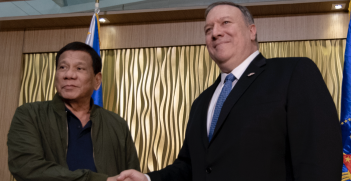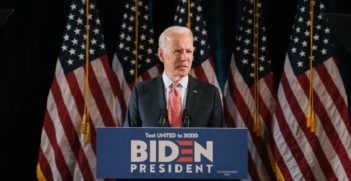US-Turkish “Safe Zones” Endanger Democracy in North-Eastern Syria

Trump and Erdogan have found it convenient to collaborate on Syria for the moment. But the announcement of US-Turkish cooperation to establish “safe zones” in north-eastern Syria does not herald a thaw in relations between the two NATO allies, and may endanger the democracy at work in the Democratic Federation of Northern Syria.
Earlier this month, the international press reported with alarm that the Turkish military was poised to invade Syria. President Recep Tayyip Erdoğan’s announcement that the Turkish army would be advancing east of the Euphrates – where about 2,000 US troops remain stationed alongside Syrian Democratic Forces (SDF) – re-ignited fears of a direct military confrontation between Turkey and the United States. Had this happened, it would have marked the first conflict among North Atlantic Treaty Organisation (NATO) members in the organisation’s history. Instead, the Trump administration quickly announced the formation of a joint US-Turkish task force to establish “safe zones” in north-eastern Syria and the threat of conflict seemed to dissipate as swiftly as it had arisen.
The announcement of military cooperation between the United States and Turkey in Syria may seem surprising given the belligerency that has characterised relations between the two NATO members since 2016. Yet US-Turkish cooperation on a Syrian “safe zone” does not signal an incipient rapprochement; nor does it mean that the US has prevented a Turkish invasion of Syria. This invasion has in fact been underway since 2016, when Turkey launched its ongoing campaign to roll back the gains of the SDF in north-eastern Syria. Erdogan is intent on eliminating not only the “terrorists” of the People’s Protection Units (YPG) – the backbone of SDF fighting forces – but also the radical political project that they have spearheaded in the Democratic Federation of Northern Syria (DFNS), which encompassed a third of Syrian territory at its peak. While Turkey captured and occupied 3,460 square kilometres of SDF territory across the border, the US has stayed on the sidelines. Now, as the forward march of expansionism moves Turkish troops towards Manbij, a strategic town on the western bank of the Euphrates that serves as the operational centre of the international coalition against ISIL, the US has stepped in. The US, at loggerheads with the European Union over Iran, cannot afford the risk of a direct conflict with Turkey, which threatens to bring NATO’s internal divisions to a head. Thus, rather than averting a Turkish invasion of Syria, it has agreed to chaperone it.
US-Turkish relations have been deteriorating since the failed 2016 coup against the Justice and Development Party (AKP) president. Erdoğan’s suspicion of US involvement led him to seek Russia’s protection, which it has now delivered, with the first shipment of the Russian S-400 air defence missile system arriving in Ankara on 12 July this year. Washington has repeatedly threatened retaliation in response to Turkey’s progressive defection from the American to the Russian military-industrial complex. Following the delivery of the Russian weapons, Trump followed through on one, formally expelled Turkey from the F-35 fighter jet programme, which would have made its airforce the best in the region. Erdoğan’s threat to march his forces across the Euphrates was the next round in this game of tit-for-tat. Yet rather than impose the congressionally mandated sanctions that US lawmakers have been clamouring to slap on Turkey since Trump reluctantly signed them into law in 2017, the US president opted to collaborate with his Turkish counterpart in his ambition to progressively remove SDF fighters from the lands they liberated from ISIS.
This cooperation emerges from the opportunism of two presidents seeking to negotiate contradictory pressures from an increasingly precarious position. Trump rose to power promising a war-weary American public that he would bring a definitive end to the US’s long and costly “war on terror.” As economic misery erodes the faith of those who had believed Trump’s claim that he would “make America great again,” disapproval ratings continue to rise, intensifying pressure on Trump to carry through on the promise he made, nine months ago, to withdraw US troops from Syria. Resistance from within the US military and political establishment, which remains overwhelmingly committed maintaining a presence in Syria for strategic reasons, has frustrated him so far. While upstanding members of Congress express fears over the fate of “our Kurdish allies” in the event of a US withdrawal, military minds consider the risk of losing the SDF – one of the US’s only remaining, reliable, and effective partners on the ground capable of acting against Iran. Trump’s decision to cooperate with Turkey on the “safe zones” aims to appease the hawks by providing the appearance of intervention, which disguises the reality of a carefully choreographed retreat made necessary by the weakening of the US’s global position.
Erdogan sees in the “safe zones” the chance to kill two birds with one stone. In addition to advancing his mission to eliminate the People’s Protection Unit (YPG), Erdogan has pursued the policy with growing urgency as the political crisis in Turkey has deepened. Erdogan currently faces a mounting challenge from the old guard of Turkish politics, the Republican People’s Party (CHP), to which the AKP president recently lost his own seat of Istanbul twice. Popular resistance has also swelled as Turkey’s economy has continued to spiral – in part due to US sanctions, in part to decades of neoliberal restructuring – and as the state has turned increasingly to repression to contain the dissent directed against it. A million workers entered the ranks of the jobless in the past year, bringing unemployment to a decade high of 14.7 percent; 22,000 workers have lost their lives in workplace accidents since 2002. The arrival of 3.6 million Syrian refugees brought increased competition to a bleak labour market, and some Turkish workers – not unlike their US counterparts – have directed their anger towards the migrants (rather than the Turkish elites who profit from their hyper exploitable labour. In this context, Erdogan has reversed his welcome of the refugees, and begun a process of forcibly resettling Syrians in the “safe zones” policed by the Turkish army and its mercenaries. Erdogan has revived irredentist claims from the post-WWI period to legitimise his aspiration to establish Turkish-controlled mass resettlement zones across a swath of territory across Syria into Iraq that he labels, unironically, a “peace corridor.” All of this would seem to suggest a grand strategy to definitively annihilate the YPG – first militarily, and subsequently through demographic re-engineering that would involve the expulsion of the multi-ethnic SDF forces and repopulating the area with Turkish-backed, Turkmen militias and Syrian refugees, thereby thwarting Kurdish nationalist claims to sovereignty. Yet this apparent master plan stands in stark contradiction to Turkey’s commitments to respecting Syria’s territorial integrity, which it reaffirmed in a joint statement with Iran and the Assad government on 2 August.
Behind the bombastic tweets and bellicose language, both Trump and Erdogan are contending with the development, on the ground, of a new political reality, whose development has progressed too quickly for most analysis to keep pace. Some have speculated about how Erdogan’s resettlement program might affect Kurdish aspirations for statehood. This ignores the position of the dominant faction in the SDF coalition, which rejects nationalism as the legitimate principle of political sovereignty. In north-eastern Syria, a radical experiment is underway, born out of the Arab Spring and reared in the fires of war. The Democratic Federation of Northern Syria (DFNS) is building a society that operates on the basis of a decentralised participatory democracy based on the principles of ecosocialism, the abolition of private property, and an indigenised feminism called jineology – derived from the Kurdish word for woman.
Behind the scenes, the US has relayed communications between the SDF leadership and the Turkish government to negotiate the terms of the “safe zone.” The SDF’s co-commanders have clearly stated their conditions for the safe zone, and expressed optimism that indirect talks would yield a peaceful agreement. At the same time, they have declared their willingness to fight if Turkey violates their terms. The outcome of the negotiations will have a significant hand in determining the fate of not only of the DFNS, but also the 4.6 million people who have found peace there after years of brutal conflict.
Dr Stephanie Wright is an associate lecturer in Middle Eastern Studies at the Australian National University in Canberra.
This article is published under a Creative Commons Licence and may be republished with attribution.





